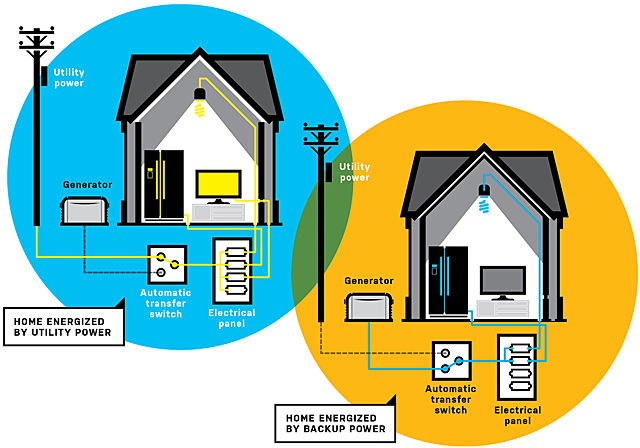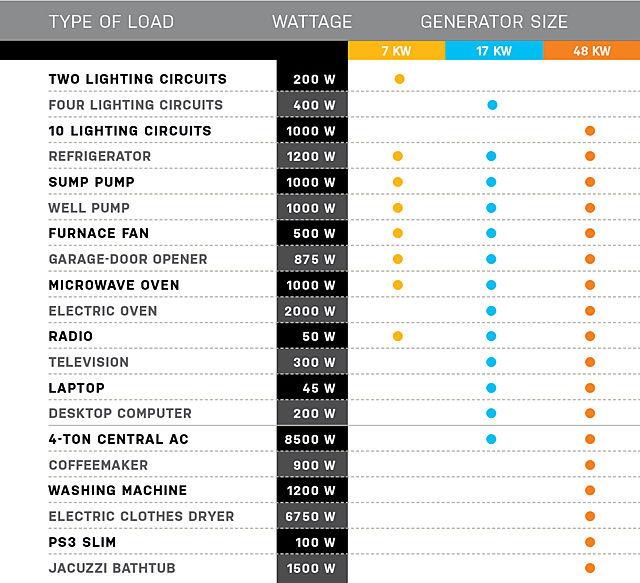Backup Generator Buying and Sizing Guide
Enjoy reading the latest DIY articles and saving money?
Receive our latest helpful hints, tricks and savings, directly to your inbox.
Posted June 1, 2017
Two weeks ago, we talked about the benefits of owning a generator. Although we shared a lot of useful information, such as considering the power source and installation company, there is a lot more to consider when purchasing a backup generator, especially when choosing its size.
If you don’t have the right-sized generator for your home, you could risk premature failure, capacity overload, reduced equipment life, and hazardous situations. So, if you are thinking about buying a new backup generator (or replacing an existing one), you will want to make sure it is properly sized (the same goes for new HVAC systems as well).
Keep in mind that no online backup generator buying and sizing guide is a substitute for a licensed electrician to calculate your power generator requirements.
What to Look for in New Backup Generator
In addition to potentially reducing your insurance rate, backup generators can power your home for several days, allowing a household to continue to be productive and comfortable, even in the middle of a blackout. This is especially important for homes with the young and elderly.
Also, if you run your business out of your home, you will definitely want uninterrupted power. Don’t risk losing a day’s or week’s worth of work due to an electrical outage!
In areas where severe electrical storms and power outages happen on a regular basis, it makes sense to look into a backup generator.
Source: Popular Mechanics
In addition to providing uninterrupted power to your home, the transfer switch also acts as a safeguard against back-feeding electricity, which could damage electronics and causes fires.
Generator Sizing Guide
Although the following sizing guide will give you some idea of the size and price range of your backup generator, you will ALWAY want to hire a professional to calculate your electrical load needs. There is no single sizing solution for all homes.
Also, installing your own backup generator is never a good idea. The installation process requires advanced electrical and and plumbing expertise, including knowledge of local codes, permits, and inspections. As the National Electrical Code (NEC) gets updated, new requirements may be adopted.
Whole home backup generators are available in sizes ranging from 5-50 kilowatts (KW). You can use portable generators for small offices, RV’s, and tailgate parties, and industrial sized generators for businesses, data centers, and other larger buildings.
The size and power of the generator is determined by a variety of factors including the size of your home, the type of fuel preferred, and the wattage requirements of your appliances. Don’t forget to take into consideration load growth, seasonal changes, and different types of motors.
Most retail sites that carry generator units offer a handy calculator to help select a size for your specific needs.
Use the image below to help determine the right sized generator for your home:
Source: Popular Mechanics
How to Size Your Backup Generator:
- List all of the items that you intend to power next to their starting and running wattage requirements. This is normally located on a label on the device itself, or in the owner’s manual. Most owner’s manuals are online now, so you can look it up if you can’t find it. You can also estimate your appliance’s energy consumption with this appliance energy calculator from the U.S. Department of Energy.
- If the power requirements are listed in amps, you can easily convert them to watts with this amp-to-watt conversion calculator or with this formula: Watt = Amp x Volt.Remember that 1 kilowatt = 1,000 watts. You should always convert Amps to kW when determining generator size.
- Add up all of the required watts for the devices your will be powering simultaneously. If you know all of the wattage requirements, then you can skip the process of addition with this Wattage Requirement Calculator.
- This sum is going to be the general size of generator you need.
Those three steps are all you really need to estimate the size of your home backup generator.
Keep in mind that there is a lot of room for error. For instance, if you don’t properly account for mixing voltages, you could end up with an improperly sized generator.
Portable Generators
If you are just looking for a portable backup generator for tailgate parties, camping, and other outdoor events, then you will want to follow the similar steps of adding up all the electrical devices you will need to power, followed by the amount of time they will be on, and finally if your generator has the power to handle it.
Shortcut Generator Sizing Guide
The best way to size your generator is to first calculate the electrical demand of your HVAC unit, by far the largest consumer of electricity in the home.
Find your air conditioning unit and look for tons, BTUs, or Amps. If you can’t find the label on the unit, look for the A/C’s breaker in your circuit panel. Is it 30-Amp, 40-Amp, or 50-Amp?
- If you have a 3-ton (30-Amp, 36,000 BTUs) air conditioner, you need at least a 14 KW generator.
- If you have a 4-ton (40-Amp, 48,000 BTUs) air conditioner, you need at least a 17 KW generator.
- If you have a 5-ton (50-Amp, 60,000 BTUs) air conditioner, you need at least a 20 KW generator.
All HVAC units should have an ENERGYGUIDE label that tells you important information about your appliance’s energy use:
Source: consumer.ftc.gov
Although not all appliances are required to have this label, your biggest appliances will most certainly have one. This makes it easy to estimate your home’s total energy use.
Generator Sizes and Costs
All backup generators will have two different power ratings, one is “starting” or “rated” and the other is “running” or “continuous.” The lower “running” number is the only rating you should look for. The higher rating is not meant to run at that power level. It can only maintain that extra power for a few seconds when a device starts up.
5-12 kW generator costs between $3,000 and $5,000 and will be able to power most of your smaller essential appliances, like microwaves, computers, sump pumps, and fridges. It probably won’t be able to run your air conditioning system or washer/dryer.
12-20 kW generator costs between $3,000 and $8,000 and is considered mid-sized. Some mid-size generators contain load-shedding devices that turn off nonessential devices in order to power the essential ones.
20-50 kW generator costs between $5,000 and $20,000 and is a considered a true whole-house generator. These generators are typically powerful enough to energize all of the electronics and appliances in your home, without the need for load-shedding.
Generator Fuel
When choosing the type of fuel source for your backup generator, natural gas or propane, it is often dictated by the location of your home. In most metropolitan areas, natural gas is the more common fuel used to power ranges, burners, grills, space heaters and more.
However, people in less populated and rural areas without gas service use propane to fuel their appliances. While not as convenient as natural gas, propane can be stored in tanks and stockpiled.
Generator Features
Although many generators have these attributes, you will want to double-check these features:
- Quiet operation
- Easy to use
- Energy-efficient
- Battery included
- Air–cooled engine
- Weekly self–test
Generator Maintenance
Unfortunately, you aren’t done once you choose and install a backup generator. They require ongoing maintenance, just like your other large appliances. Bigger units tend to require more attention.
Your generator can serve you faithfully for a long time if you run it no more than 75% of its rated capacity, check the oil level after every use, and remember to have it professionally serviced at least every year. You may have to service it more often depending on how often you use your generator, but even if you haven’t needed it the whole year, you should still have it serviced once a year.
We recommend scheduling generator maintenance in the fall before the onset of winter, when there is a good chance of cold and stormy weather. Winter is when generators are called on most, so make sure it is working properly before the cold weather hits.
The second time that you should schedule generator maintenance is in the wake of its extended use. If you have used your generator for over 24 hours of continuous use, it’s a good idea to have it serviced.
During a generator maintenance inspection, your technician will check all connections, clean it, and replace fuel if necessary.
For more maintenance tips, read Family Handyman’s generator maintenance guide.
Call Hiller Plumbing, Heating, Cooling & Electrical for 24/7 generator repair service and maintenance.
Our certified electricians install all types of backup generators and will make sure your generator is sized and installed properly. We adhere to all local and national codes, and can take care of all the wiring and maintenance.
It’s important to hire a certified electrician for generator installations to ensure that the equipment is sized correctly to protect you and your home.
 Daily Promotion
Daily Promotion
0% Interest for 12 Months on Select New Tankless Water Heater
Purchase Select New Tankless Water Heater & Receive 0% Interest for 12 Months. Click below to see financing terms.
Get Promotion


